Energy Equivalence Based Estimation of Hybrid Composites Mechanical Properties
Abstract
:1. Introduction
2. Theoretical Formulation
2.1. Basic Ideas
- Each inclusion within the RVE matrix is subjected to the same stress field derived from the external tractions applied at the boundary of this element.
- The effect of all other inclusions within the RVE matrix on the observed inclusion is measured through the change of effective composite stiffness or compliance.
- For the isotropic short fiber-reinforced composites the exact spatial correlation of the inclusions within the RVE has negligible influence on the effective composite properties defined within the element.
2.2. Effective Elastic Properties of Hybrid Composite Material
- (1)
- when a homogeneous pure matrix material is considered, therefore the stiffness tensor (7) becomes the stiffness tensor of the matrix material:
- (2)
- when the volume fraction of one of the reinforcement materials is equal to 1 (a homogeneous pure inclusion material is then considered). This second condition involves two cases: , and :
3. Results
3.1. Parametric Studies
3.2. Validation
4. Conclusions
Author Contributions
Funding
Institutional Review Board Statement
Informed Consent Statement
Data Availability Statement
Conflicts of Interest
References
- Haris, N.I.N.; Hassan, M.Z.; Ilyas, R.A.; Suhot, M.A.; Sapuan, S.M.; Dolah, R.; Mohammad, R.; Asyraf, M.R.M. Dynamic mechanical properties of natural fiber reinforced hybrid polymer composites: A review. J. Mater. Res. Technol. 2022, 19, 167–182. [Google Scholar] [CrossRef]
- Jamir, M.R.M.; Majid, M.S.A.; Khasri, A. Natural Lightweight Hybrid Composites for Aircraft Structural Applications. In Sustainable Composites for Aerospace Applications; Jawaid, M., Thariq, M., Eds.; Woodhead Publishing Series in Composites Science and Engineering; Woodhead Publishing: Cambridge, UK, 2018; pp. 155–170. [Google Scholar]
- Shahzad, A. Investigation into Fatigue Strength of Natural/Synthetic Fiber-Based Composite Materials. In Mechanical and Physical Testing of Biocomposites, Fibre-Reinforced Composites and Hybrid Composites; Jawaid, M., Thariq, M., Saba, N., Eds.; Woodhead Publishing Series in Composites Science and Engineering; Woodhead Publishing: Cambridge, UK, 2019; pp. 215–239. [Google Scholar]
- Dong, C. Review of natural fibre-reinforced hybrid composites. J. Reinforc. Plast. Compos. 2017, 37, 331–348. [Google Scholar] [CrossRef] [Green Version]
- Saleem, A.; Medina, L.; Skrifvars, M.; Berglin, L. Hybrid Polymer Composites of Bio-Based Bast Fibers with Glass, Carbon and Basalt Fibers for Automotive Applications—A Review. Molecules 2020, 25, 4933. [Google Scholar] [CrossRef] [PubMed]
- Muthalagu, R.; Murugesan, J.; Sathees Kumar, S.; Sridhar Babu, B. Tensile attributes and material analysis of kevlar and date palm fibers reinforced epoxy composites for automotive bumper applications. Mater. Today Proc. 2021, 46, 433–438. [Google Scholar] [CrossRef]
- Ganesarajan, D.; Simon, L.; Tamrakar, S.; Kiziltas, A.; Mielewski, D.; Behabtu, N.; Lenges, C. Hybrid composites with engineered polysaccharides for automotive lightweight. Compos. Part C Open Access 2022, 7, 100222. [Google Scholar] [CrossRef]
- Jaafar, C.N.A.; Zainol, I.; Ishak, N.S.; Ilyas, R.A.; Sapuan, S.M. Effects of the liquid natural rubber (LNR) on mechanical properties and microstructure of epoxy/silica/kenaf hybrid composite for potential automotive applications. J. Mater. Res. Technol. 2021, 12, 1026–1038. [Google Scholar] [CrossRef]
- Mansor, M.R.; Sapuan, S.M.; Zainudin, E.S.; Nuraini, A.A.; Hambali, A. Hybrid natural and glass fibers reinforced polymer composites material selection using Analytical Hierarchy Process for automotive brake lever design. Mater. Des. 2013, 51, 484–492. [Google Scholar] [CrossRef]
- Dattatreya, K.; Sathees Kumar, S.; Prasad, V.V.S.H.; Pati, P.R. Mechanical properties of waste natural fibers/fillers reinforced epoxy hybrid composites for automotive applications. Mater. Today Proc. 2023. [Google Scholar] [CrossRef]
- Bagheri, Z.S.; Sawi, I.E.; Schemitsch, E.H.; Zdero, R.; Bougherara, H. Biomechanical properties of an advanced new carbon/flax/epoxy composite material for bone plate applications. J. Mech. Behav. Biomed. Mater. 2013, 20, 398–406. [Google Scholar] [CrossRef]
- Scutaru, M.L.; Baba, M. Investigation of the Mechanical Properties of Hybrid Carbon-Hemp Laminated Composites Used as Thermal Insulation for Different Industrial Applications. Adv. Mech. Eng. 2014, 6, 829426. [Google Scholar] [CrossRef] [Green Version]
- Cicala, G.; Cristaldi, G.; Recca, G.; Ziegmann, G.; El-Sabbagh, A.; Dickert, M. Properties and performances of various hybrid glass/natural fibre composites for curved pipes. Mater. Des. 2009, 30, 2538–2542. [Google Scholar] [CrossRef]
- Critchfield, M.O.; Judy, T.D.; Kurzweil, A.D. Low-cost design and fabrication of composite ship structures. Mar. Struct. 1994, 7, 475–494. [Google Scholar] [CrossRef]
- Panthapulakkal, S.; Sain, M. Injection-molded short hemp fiber/glass fiber-reinforced polypropylene hybrid composites—Mechanical, water absorption and thermal properties. J. Appl. Polym. Sci. 2007, 103, 2432–2441. [Google Scholar] [CrossRef]
- Voigt, W. Über die Beziehungen zwischen den beiden Elastizitäskonstanten isotroper Körper. Wied. Ann. 1889, 38, 573–587. [Google Scholar] [CrossRef] [Green Version]
- Reuss, A. Berechnung der Fliessgrenze von Mischkristallen auf Grund der Plastizitätsbedingung für Einkristalle. Z. Angew. Math. Mech. 1929, 9, 49–58. [Google Scholar] [CrossRef]
- Hill, R. A theory of the yielding and plastic flow of anisotropic materials. Proc. R. Soc. Lond. A 1948, 193, 281–297. [Google Scholar]
- Hashin, Z.; Shtrikman, S. A variational approach to the theory of the elastic behaviour of polycrystals. J. Mech. Phys. Solid 1962, 10, 343–352. [Google Scholar] [CrossRef]
- Miloh, T.; Benveniste, Y. A Generalized Self-Consistent Method for the Effective Conductivity of Composites With Ellipsoidal Inclusions and Cracked Bodies. J. Appl. Phys. 1988, 63, 789–796. [Google Scholar] [CrossRef]
- Nazarenko, L.; Stolarski, H.; Altenbach, H. Effective properties of particulate composites with surface-varying interphases. Compos. B Eng. 2018, 149, 268–284. [Google Scholar] [CrossRef]
- Sun, C.T.; Vaidya, R.S. Prediction of composite properties from a representative volume element. Compos. Sci. Technol. 1996, 56, 171–179. [Google Scholar] [CrossRef]
- Gan, H.; Orozco, C.E.; Herakovich, C.T. A strain-compatible method for micromechanical analysis of multi-phase composites. Int. J. Solid. Struct. 2000, 37, 5097–5122. [Google Scholar] [CrossRef]
- Liu, B.; Feng, X.; Zhang, S.-M. The effective Young's modulus of composites beyond the Voigt estimation due to Poisson effect. Compos. Sci. Technol. 2009, 69, 2198–2204. [Google Scholar] [CrossRef]
- Würkner, M.; Berger, H.; Gabbert, U. On numerical evaluation of effective material properties for composite structures with rhombic fiber arrangements. Int. J. Eng. Sci. 2011, 49, 322–332. [Google Scholar] [CrossRef]
- Selvadurai, A.P.S.; Nikopour, H. Transverse elasticity of a unidirectionally reinforced composite with an irregular fibre arrangement: Experiments, theory and computations. Compos. Struct. 2012, 94, 1973–1981. [Google Scholar] [CrossRef]
- Arjun, K.P.; de Barros, S.; Budhe, S. Theoretical determination of elastic and flexural modulus for inter-ply and intra-ply hybrid composite material. Compos. Struct. 2022, 281, 114971. [Google Scholar] [CrossRef]
- Mori, T.; Tanaka, K. Average stress in matrix and average elastic energy of materials with misfitting inclusions. Acta Metal. 1973, 21, 571–574. [Google Scholar] [CrossRef]
- Kanaun, S.K.; Jeulin, D. Elastic properties of hybrid composites by the effective field approach. J. Mech. Phys. Solids 2001, 49, 2339–2367. [Google Scholar] [CrossRef]
- Du, H.; Mazzeo, A.D.; Shan, J.W.; Xia, X.; Weng, G.J. Electrical response, elastic property, and pressure sensing under bending of hybrid graphene/CNT/elastomer nanocomposites. Compos. Struct. 2023, 311, 116838. [Google Scholar] [CrossRef]
- Hasanzadeh, M.; Ansari, R.; Hassanzadeh-Aghdam, M.K. Evaluation of effective properties of piezoelectric hybrid composites containing carbon nanotubes. Mech. Mater. 2019, 129, 63–79. [Google Scholar] [CrossRef]
- Bazan, P.; Nosal, P.; Wierzbicka-Miernik, A.; Kuciel, S. A novel hybrid composites based on biopolyamide 10.10 with basalt/aramid fibers: Mechanical and thermal investigation. Compos. Part B Eng. 2021, 223, 109125. [Google Scholar] [CrossRef]
- Halpin, J.C.; Tsai, S.W. Environmental factors in composite materials design. US Air Force Materials Lab. Rep. AFML Tech. Rep. 1969, 67423, 749–767. Available online: https://www.semanticscholar.org/paper/Effects-of-Environmental-Factors-on-Composite-Halpin/1a8502fad082b55755965085de1b6dad8edcbca2 (accessed on 13 February 2023).
- Ribeiro, F.J.V.; Filho, S.L.M.R.; Silveira, E.M.; Panzera, T.H.; Scarpa, F.; Tonatto, M.L.P. A sequential multiscale technique to evaluate the mechanical behaviour of hybrid composites containing carbon fibre and silica microparticles. Compos. Struct. 2023, 314, 116977. [Google Scholar] [CrossRef]
- Facca, A.G.; Kortschot, M.T.; Yan, N. Predicting the elastic modulus of natural fibre reinforced thermoplastics. Compos. Part A 2006, 37, 1660–1671. [Google Scholar] [CrossRef]
- Alkandary, A.; Netravali, A.N. Hybrid green composites using rice straw and jute fabric as reinforcement for soy protein-based resin. Compos. Part B Eng. 2023, 256, 110626. [Google Scholar] [CrossRef]
- Wang, A.; Liu, X.; Yue, Q.; Xian, G. Tensile properties hybrid effect of unidirectional flax/carbon fiber hybrid reinforced polymer composites. J. Mater. Res. Technol. 2023, 24, 1373–1389. [Google Scholar] [CrossRef]
- Wiśniewska, A.; Egner, H. Optimization of Functionally Graded Structural Members by Means of New Effective Properties Estimation Method. Materials 2019, 12, 3139. [Google Scholar] [CrossRef] [PubMed] [Green Version]
- Egner, H.; Ryś, M. Total energy equivalence in constitutive modelling of multidissipative materials. Int. J. Damage Mech. 2017, 3, 417–446. [Google Scholar] [CrossRef]
- Ryś, M.; Egner, H. Energy equivalence based constitutive model of austenitic stainless steel at cryogenic temperatures. Int. J. Solids Struct. 2019, 164, 52–65. [Google Scholar] [CrossRef]
- Egner, H.; Egner, W. Classification of Constitutive Equations for Dissipative Materials-General Review. In Mechanics of Anisotropic Materials; Skrzypek, J.J., Ganczarski, A.W., Eds.; Springer International: Cham, Switzerland, 2015; pp. 247–294. [Google Scholar]
- Wiśniewska, A.; Hernik, S.; Liber-Kneć, A.; Egner, H. Effective properties of composite material based on total strain energy equivalence. Compos. Part B Eng. 2019, 166, 213–220. [Google Scholar] [CrossRef]
- Wiśniewska, A.; Hernik, S.; Egner, H. Effective Properties of Composite Material Based on Total Strain Energy Equivalence. In Plasticity, Damage and Fracture in Advanced Materials. Advanced Structured Materials; Altenbach, H., Brünig, M., Kowalewski, Z., Eds.; Springer: Cham, Switzerland, 2020; Volume 121, pp. 201–213. [Google Scholar]
- Saanouni, K.; Forster, C.; Ben Hatira, F. On the anelastic flow with damage. Int. J. Damage Mech. 1994, 3, 140–169. [Google Scholar] [CrossRef]
- Murakami, S. Continuum Damage Mechanics: A Continuum Mechanics Approach to the Analysis of Damage and Fracture; Springer: Dordrecht, The Netherlands, 2012. [Google Scholar]
- Skrzypek, J.J.; Ganczarski, A.W.; Rustichelli, F.; Egner, H. Advanced Materials and Structures for Extreme Operating Conditions; Springer: Berlin/Heidelberg, Germany, 2008. [Google Scholar]
- Egner, H. On the full coupling between thermo-plasticity and thermo-damage in thermodynamic modeling of dissipative materials. Int. J. Solids Struct. 2012, 49, 279–288. [Google Scholar] [CrossRef] [Green Version]
- Koszkul, J. Kompozyty poliamidu 6 z włóknem szklanym. Composites 2001, 1, 159–162. [Google Scholar]
- Charrière, E.; Terrazzoni, S.; Pittet, C.; Mordasini, P.; Dutoit, M.; Lemaître, J.; Zysset, P. Mechanical characterization of brushite and hydroxyapatite cements. Biomaterials 2001, 22, 2937–2945. [Google Scholar] [CrossRef] [PubMed]
- Bonfield, W. Hydroxyapatite-Reinforced Polyethylene as an Analogous Material for Bone Replacement. Ann. N. Y. Acad. Sci. 1988, 523, 173–177. [Google Scholar] [CrossRef] [PubMed]
- Kuciel, S.; Kornobis, M. Kompozyty hybrydowe na osnowie polilaktydu z włóknami węglowymi i bazaltowymi. Przetw. Tworz. 2017, 4, 344–350. [Google Scholar]
- Lai, J. Moldflow Material Testing Report. MAT2238, NatureWorks PLA; Moldflow: Melbourne, Australia, 2007. [Google Scholar]
- Bino, D.; Retnam, B.S.J.; Ramachandran, M.; Sivapragash, M. Analysis of mechanical properties of glass and carbon fiber reinforced polymer material. Int. J. Appl. Eng. 2015, 10, 10387–10391. [Google Scholar]
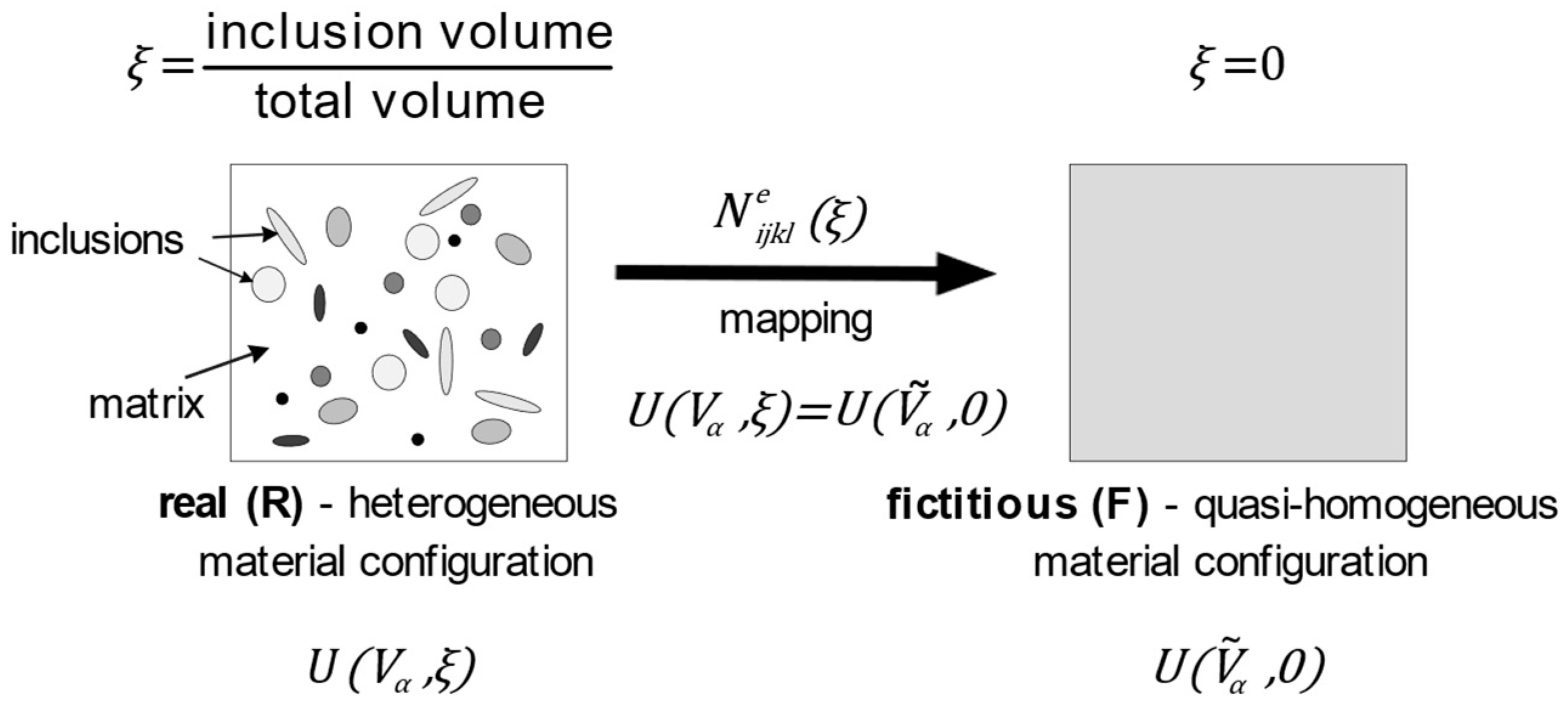
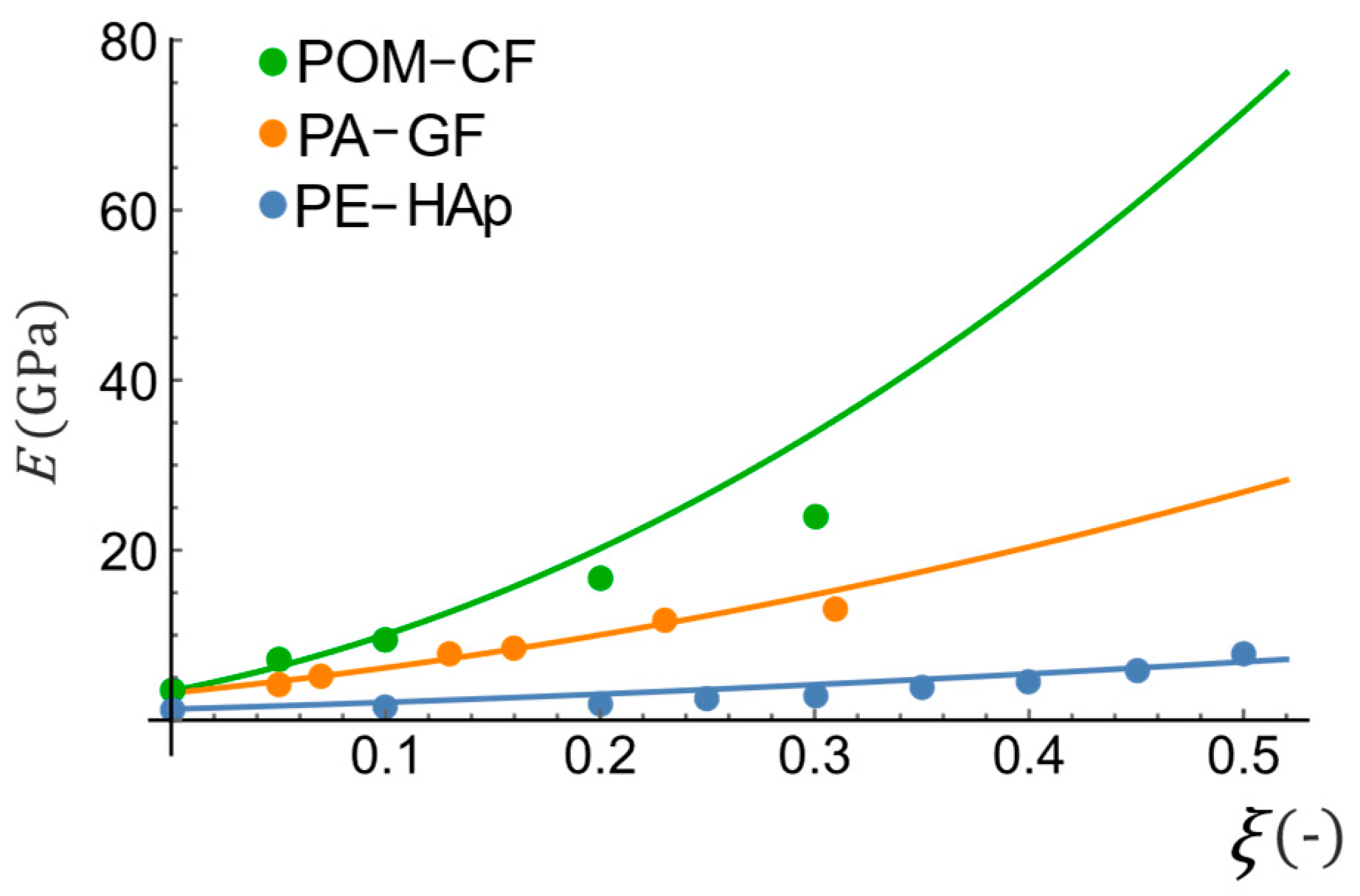
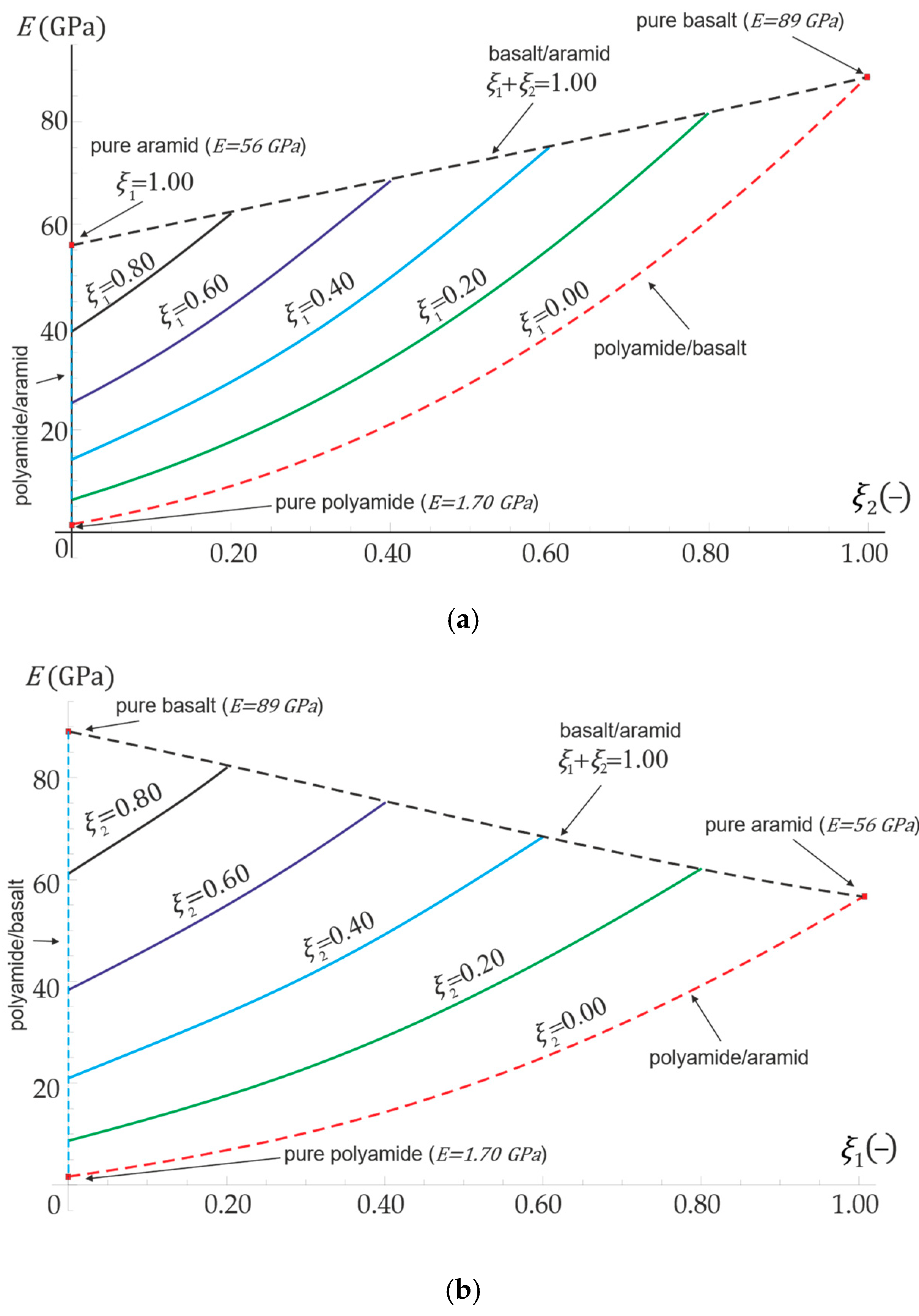
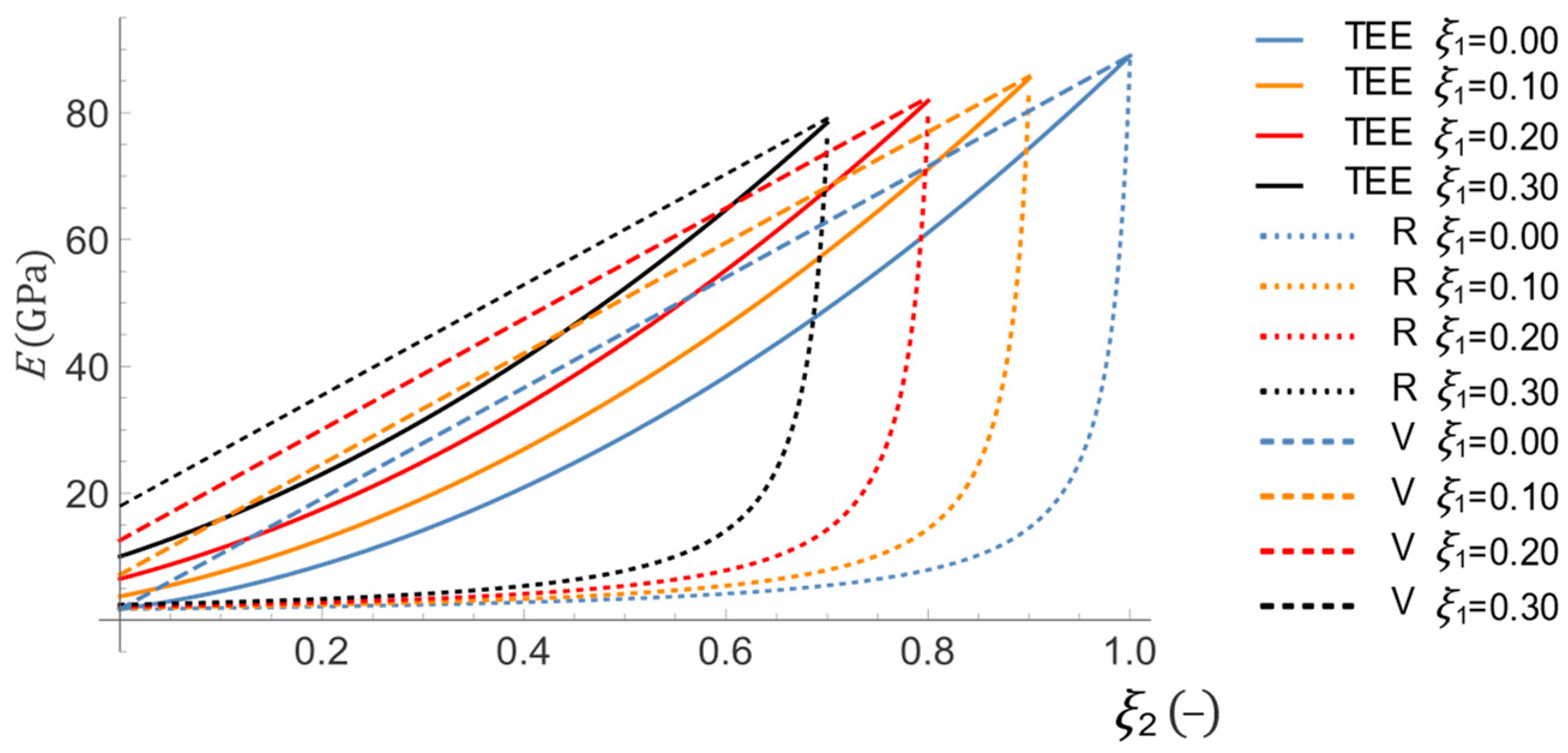
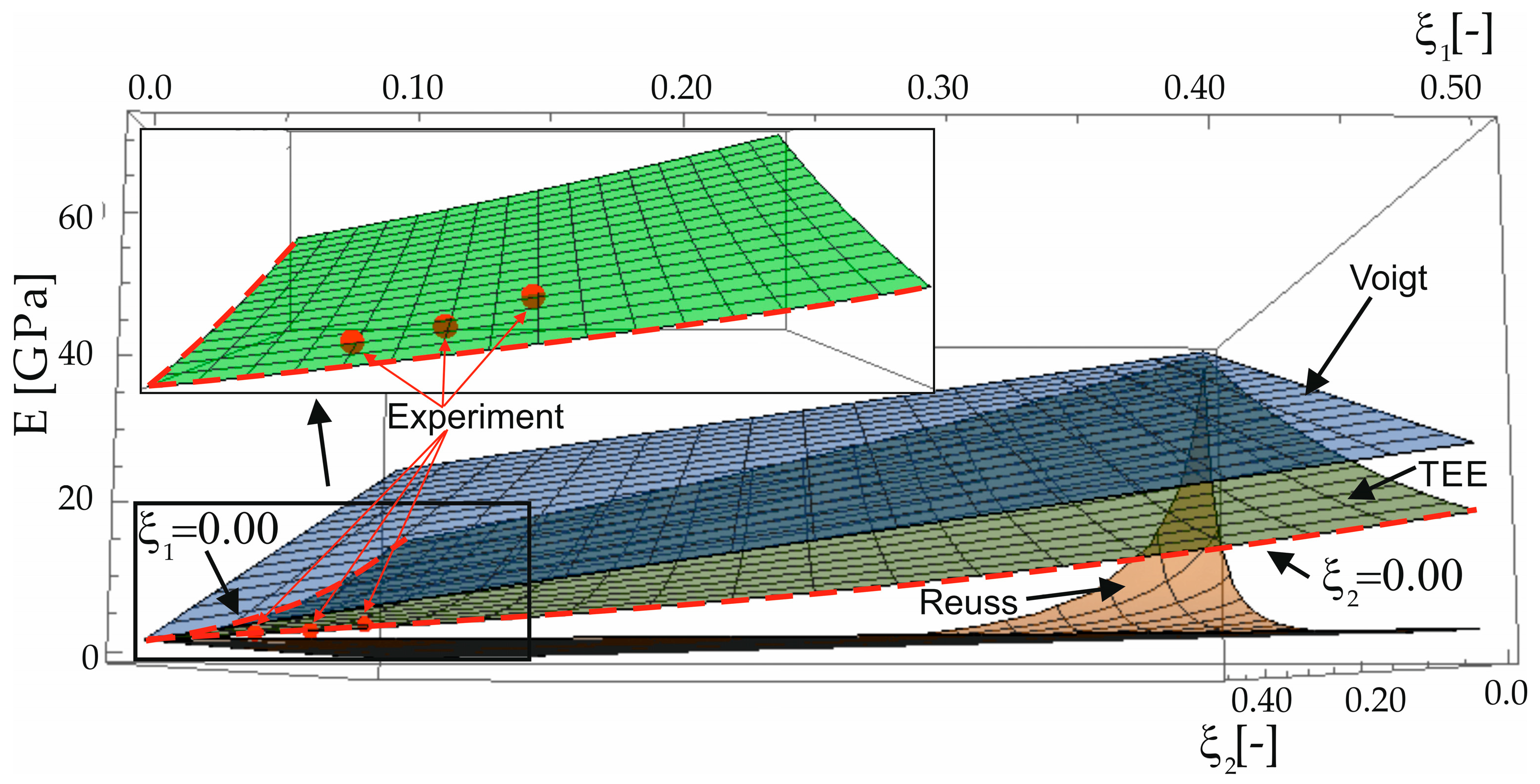
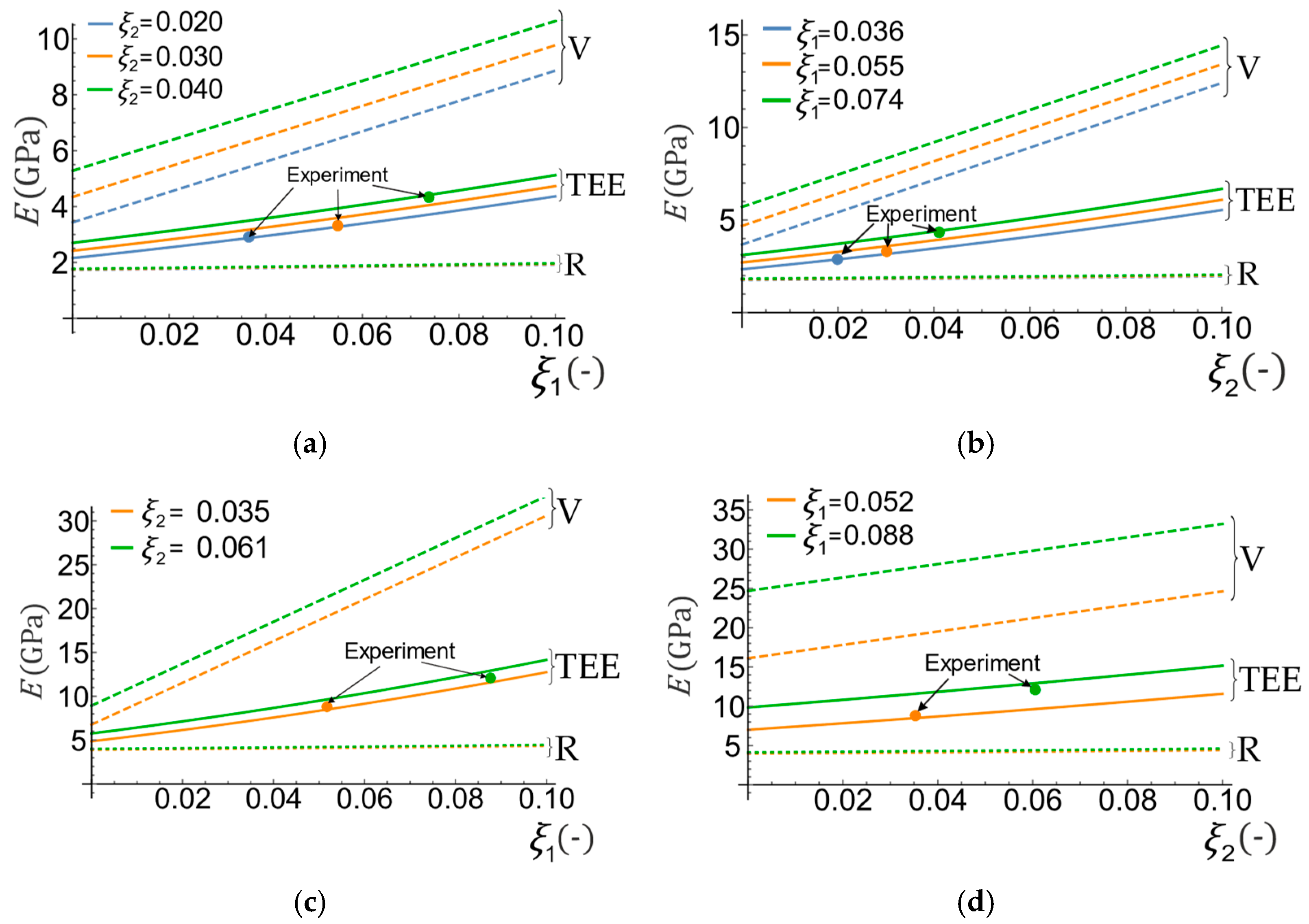
| Composite | (-) | (GPa) | Estimation Method Error (%) | |||||
|---|---|---|---|---|---|---|---|---|
| Energy Equivalence Based Method (TEE) | Voigt (V) | Reuss (R) | Hashin- Shtrikman Upper (HSU) | Hashin- Shtrikman Lower (HSL) | Mori-Tanaka (MT) | |||
| POM-CF | 0.00 | 3.42 | 0.00 | 0.00 | 0.00 | 0.00 | 0.00 | 0.00 |
| 0.05 | 7.03 | 10.31 | 107.82 | 48.83 | 32.64 | 46.17 | 46.17 | |
| 0.10 | 9.64 | 4.39 | 167.53 | 60.65 | 60.45 | 56.57 | 56.57 | |
| 0.20 | 16.58 | 21.83 | 190.39 | 74.31 | 73.20 | 69.03 | 69.03 | |
| 0.30 | 24.00 | 40.94 | 193.77 | 79.77 | 81.17 | 73.58 | 73.58 | |
| PA-GF | 0.05 | 4.04 | 13.14 | 69.78 | 16.82 | 28.26 | 12.59 | 12.59 |
| 0.07 | 5.08 | 2.03 | 63.07 | 32.49 | 17.84 | 27.70 | 27.70 | |
| 0.13 | 7.77 | 6.89 | 60.81 | 52.97 | 8.92 | 46.83 | 46.83 | |
| 0.16 | 8.57 | 2.22 | 70.12 | 55.92 | 13.70 | 48.87 | 48.87 | |
| 0.23 | 11.63 | 2.31 | 66.92 | 64.73 | 10.64 | 56.72 | 56.72 | |
| 0.31 | 13.06 | 17.09 | 90.73 | 65.18 | 27.91 | 54.70 | 54.70 | |
| PE-HAp | 0.00 | 1.30 | 0.00 | 0.00 | 0.00 | 0.00 | 0.00 | 0.00 |
| 0.10 | 1.40 | 49.99 | 110.34 | 2.25 | 59.09 | 11.73 | 11.73 | |
| 0.20 | 2.00 | 53.18 | 124.38 | 20.37 | 60.58 | 5.98 | 5.98 | |
| 0.25 | 2.50 | 44.16 | 109.51 | 32.50 | 49.26 | 17.47 | 17.47 | |
| 0.30 | 3.00 | 39.41 | 99.28 | 40.18 | 42.44 | 24.46 | 24.46 | |
| 0.35 | 3.70 | 29.66 | 81.39 | 48.22 | 30.79 | 32.63 | 32.63 | |
| 0.40 | 4.40 | 23.84 | 69.07 | 53.29 | 23.45 | 37.55 | 37.55 | |
| 0.45 | 5.90 | 4.00 | 38.33 | 62.44 | 2.61 | 48.54 | 48.54 | |
| 0.50 | 7.70 | 10.93 | 15.33 | 68.78 | 12.88 | 56.28 | 56.28 | |
| Material | (GPa) | (GPa) | (GPa) |
|---|---|---|---|
| PA | 2.36 | 1.95 | 0.62 |
| AF | 49.12 | 34.87 | 21.37 |
| BF | 61.81 | 38.26 | 35.32 |
| Material | (GPa) | (-) |
|---|---|---|
| PA | 1.70 | 0.38 |
| AF | 56.00 | 0.31 |
| BF | 89.00 | 0.26 |
| Material | (GPa) | (-) |
|---|---|---|
| PLA | 3.76 | 0.36 |
| CF | 242.00 | 0.32 |
| BF | 89.00 | 0.26 |
| Composite | (GPa) | Estimation Method | |||||||
|---|---|---|---|---|---|---|---|---|---|
| TEE | Voigt (V) | Reuss (R) | |||||||
| (GPa) | Error (%) | (GPa) | Error (%) | (GPa) | Error (%) | ||||
| PA-AF-BF | 0.036 | 0.020 | 2.89 | 2.87 | 0.61 | 5.41 | 87.19 | 1.80 | 37.77 |
| 0.055 | 0.030 | 3.31 | 3.59 | 8.61 | 7.33 | 121.40 | 1.85 | 43.99 | |
| 0.074 | 0.040 | 4.32 | 4.42 | 2.22 | 9.29 | 115.07 | 1.91 | 55.69 | |
| PLA-CF-BF | 0.052 | 0.035 | 8.84 | 8.49 | 3.93 | 19.12 | 116.27 | 4.11 | 53.52 |
| 0.088 | 0.061 | 12.13 | 12.93 | 6.62 | 29.85 | 146.12 | 4.40 | 63.77 | |
Disclaimer/Publisher’s Note: The statements, opinions and data contained in all publications are solely those of the individual author(s) and contributor(s) and not of MDPI and/or the editor(s). MDPI and/or the editor(s) disclaim responsibility for any injury to people or property resulting from any ideas, methods, instructions or products referred to in the content. |
© 2023 by the authors. Licensee MDPI, Basel, Switzerland. This article is an open access article distributed under the terms and conditions of the Creative Commons Attribution (CC BY) license (https://creativecommons.org/licenses/by/4.0/).
Share and Cite
Jerzyńska, A.; Egner, H. Energy Equivalence Based Estimation of Hybrid Composites Mechanical Properties. Materials 2023, 16, 4215. https://doi.org/10.3390/ma16124215
Jerzyńska A, Egner H. Energy Equivalence Based Estimation of Hybrid Composites Mechanical Properties. Materials. 2023; 16(12):4215. https://doi.org/10.3390/ma16124215
Chicago/Turabian StyleJerzyńska, Anna, and Halina Egner. 2023. "Energy Equivalence Based Estimation of Hybrid Composites Mechanical Properties" Materials 16, no. 12: 4215. https://doi.org/10.3390/ma16124215





